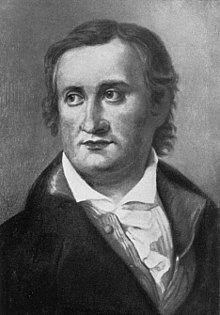Thomas Johann Seebeck
Thomas Johann Seebeck (born March 29, jul. / 9. April 1770 greg. In Reval ; † 10. December 1831 in Berlin ) was a German physicist .
Life
Thomas Seebeck was born on April 9, 1770 in what is now Tallinn into a wealthy merchant family. His father was of German descent and therefore promoted his son's medical training at the universities of Berlin and Göttingen . In 1802 he graduated as a doctor and practiced in Göttingen. However, he decided to switch to physical research, so he is better known as a physicist than as a doctor. He went to Jena , Bayreuth and Nuremberg as a private scholar and did scientific studies.
Seebeck lived in Bayreuth from 1795 to 1802 and from 1810 to 1812. Here he married Juliane Amalie Ulrike, a daughter of the royal Prussian court chamber councilor Moritz Boyé, in 1795 . Six of Seebeck's eight children were born in Bayreuth. His son August also became a physicist, his son Moritz a pedagogue and state councilor.
He met Johann Wolfgang von Goethe , with whom he was working on the theory of colors and colored light.
He investigated the warming effect of different colors in the solar spectrum . In 1808 he was the first to produce potassium amalgam and in 1810 noticed the color sensitivity of moist silver (I) oxide (a precursor to color photography ). In the same year he observed the magnetism of nickel and cobalt. In 1818 he discovered the optical activity (rotation of the plane of polarization) of sugar solutions. He then returned to Berlin University and dealt with the electrical magnetization of iron and steel . In 1809 he was accepted as a corresponding member of the Bavarian Academy of Sciences . In 1818 he was elected a member of the Leopoldina . In 1821 he discovered the thermoelectric effect ( Seebeck effect ).
Seebeck set up a thermoelectric series of voltages in 1823 and published his thermomagnetic work in "Magnetic polarization of metals and ores through temperature difference. Treatises of the Prussian Academy of Sciences ”. He worked for 13 years at the Berlin Academy of Sciences . On December 26, 1825, he was accepted as a corresponding member of the Académie des sciences .
In his hometown of Reval, the Seebeck monument was erected in his honor on the grounds of the Technical University .
literature
- Ludwig Stieda : Seebeck, Thomas Johann . In: Allgemeine Deutsche Biographie (ADB). Volume 33, Duncker & Humblot, Leipzig 1891, p. 564 f.
- Wolfgang Mathis: Seebeck, Thomas Johann. In: New German Biography (NDB). Volume 24, Duncker & Humblot, Berlin 2010, ISBN 978-3-428-11205-0 , p. 132 f. ( Digitized version ).
Web links
- Baltic Historical Commission (Ed.): Entry on Thomas Johann Seebeck. In: BBLD - Baltic Biographical Lexicon digital
- “Magnetic polarization of metals and ores through temperature difference. Treatises of the Prussian Academy of Sciences "
Individual evidence
- ↑ BM: Memorial plaque for a great physicist . In: Heimatkurier - the historical magazine of the North Bavarian Courier , issue 2/2007
- ^ List of members since 1666: Letter S. Académie des sciences, accessed on February 28, 2020 (French).
| personal data | |
|---|---|
| SURNAME | Seebeck, Thomas Johann |
| BRIEF DESCRIPTION | German physicist |
| DATE OF BIRTH | April 9, 1770 |
| PLACE OF BIRTH | Tallinn |
| DATE OF DEATH | December 10, 1831 |
| Place of death | Berlin |

